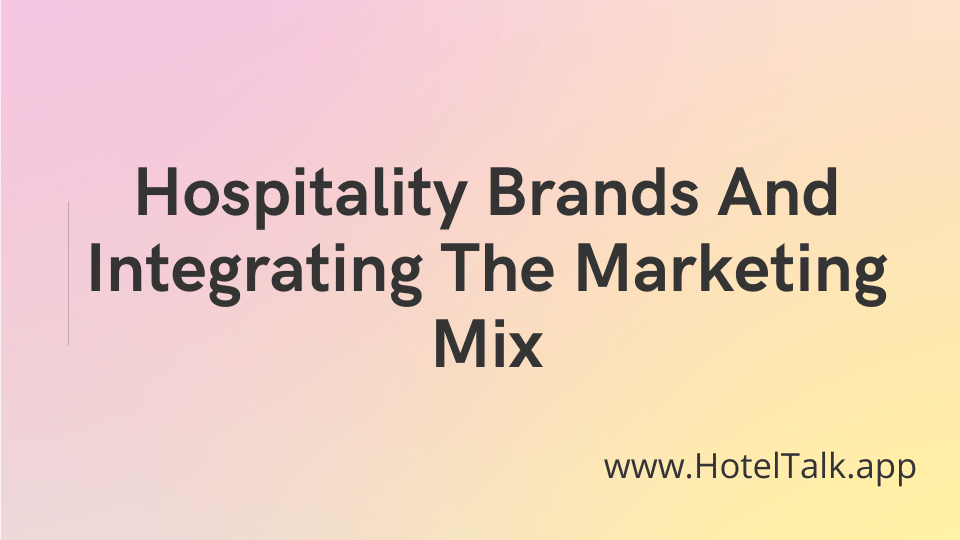Brands are essential in the marketing of multi-unit hospitality businesses. Hospitality companies create branded concepts and then blend the elements of the marketing mix to provide target customers with a better brand offer than their competitors. Each component of the marketing mix must be consistent with the others. A luxury hotel brand, for example, cannot be successfully located in a ‘down market’ area, and a cheap and cheerful restaurant cannot successfully promote gourmet cooking.
Customers are confused by mixed messages sent by hospitality companies that do not provide a consistent marketing offer. Understanding the complexity of the marketing offer is made easier by breaking down each element of the marketing mix. Customers form opinions based on their overall impression of the offer, which can be influenced by minor items, such as the price of a drink, as well as more obvious factors, such as the quality of service.
When considering all aspects of the marketing mix, it is clear that marketers must collaborate closely with operations (on product, process, and physical environment decisions), finance (on pricing and marcom budget decisions), and human resources (on employment strategies). Integration of marketing with other departments is easier in smaller, single-unit operations where the owner/management is close to the business and responsible for all decisions. Such cooperation is much more difficult to achieve in large-scale, multi-unit, national, and international operations. Effective marketing requires the collaboration of all departments in a hospitality business.
The three marketing mixes
Because hospitality products are perishable and inseparable, marketers must consider producing three marketing mixes, each aimed at influencing demand at a different time.
Before the customer arrives at the property to sample the food or stay, the marketer must identify and influence customer expectations while also attempting to generate a first-time purchase. Because it occurs before the customer has an encounter with the service provider, the first marketing mix is known as the pre-encounter marketing mix.
The encounter marketing mix refers to the second marketing mix, which occurs at the point of sale and consumption. This marketing mix’s task is to create a service experience that meets or exceeds the customer’s expectations in order to avoid customer dissatisfaction and negative word-of-mouth. The third marketing mix is known as the post-encounter marketing mix because it is intended to influence customers after they have received service in order to establish a long-term relationship.
At each stage – before, during, and after the encounter – different components of the eight-element marketing mix are important. Marketing communications such as advertising, selling, price lists, and brochures influence expectations prior to the encounter. Marketers must understand the product/service expectations of customers when designing offers for them. They must also make it easy to buy their products by establishing appropriate distribution channels.
During the encounter, customers come in to contact with the people element of the marketing mix (employees and other customers), processes, and physical evidence at locations where the service is produced and consumed.
Following the encounter, hospitality marketers will want to communicate with customers to learn what they thought of the experience, identify and resolve customer complaints, and encourage the customer to return and spread positive word-of-mouth. Marketing communications are thus used to generate future demand from current customers. The table summarises what is critical at each stage of the customer’s relationship with the company.
Table Marketing Before, During and After the Encounter (✓ Indicates which Element is Important in each Particular Marketing Mix)

Conclusion
One common misconception is that marketing is synonymous with “selling and advertising.” This chapter has demonstrated that marketing is much more than just promotional tools. Indeed, effective marketing touches almost every aspect of a hospitality organisation.
In this chapter, we have explained:
● That marketing is a business philosophy that places the customer at the center of the hospitality organization
● The essential purpose of marketing, which is to manage demand
● How marketing-led companies seek to satisfy customers better than competitors
● Why marketers need to scan the PESTE and micro-environment to understand future changes in the marketplace
● The special characteristics of hospitality (SIPIVISH) and why marketers need to understand them
● The hospitality marketing mix, which comprises eight factors that need to be integrated and consistent to ensure brand integrity
● How marketers work to influence demand before, during and after the service encounter.
